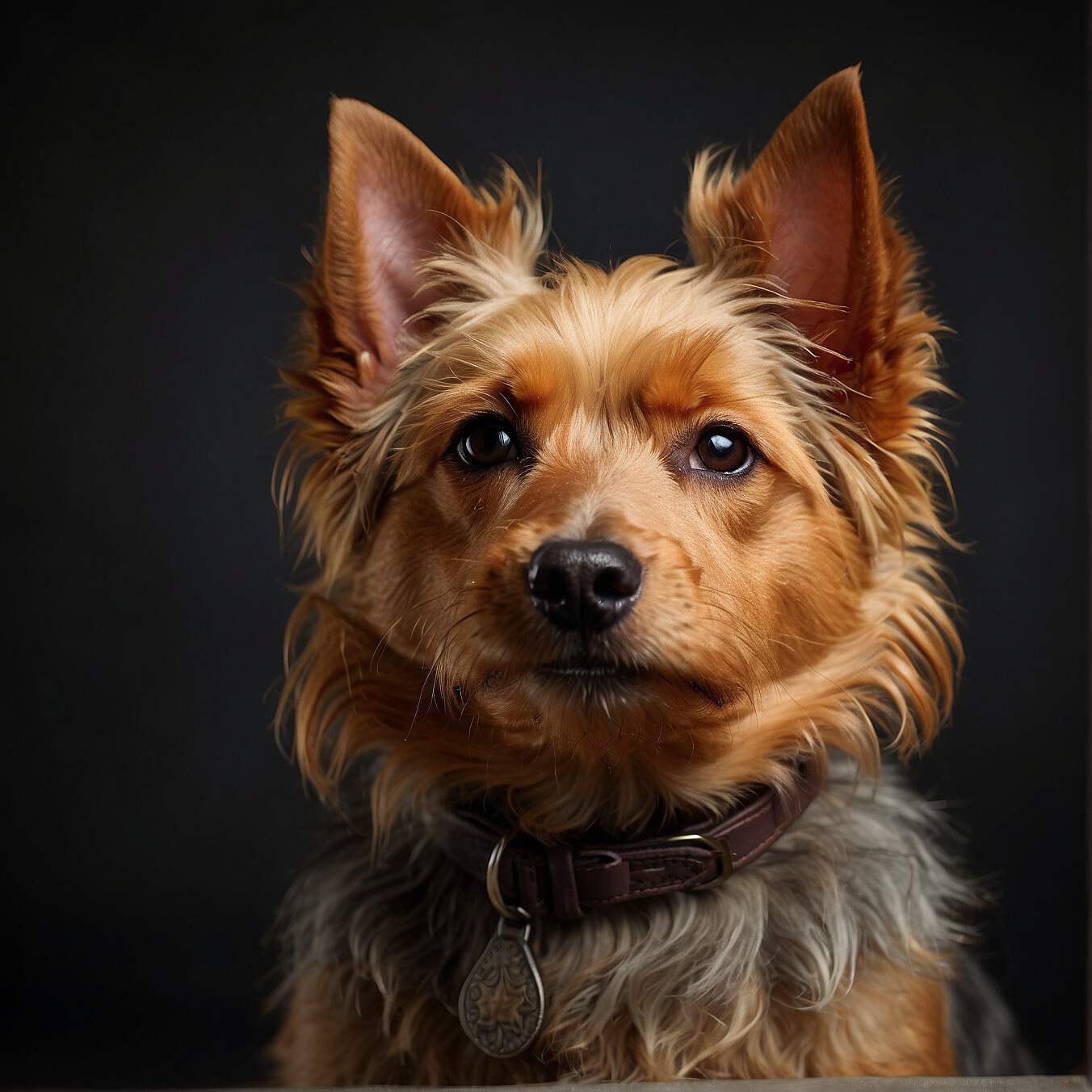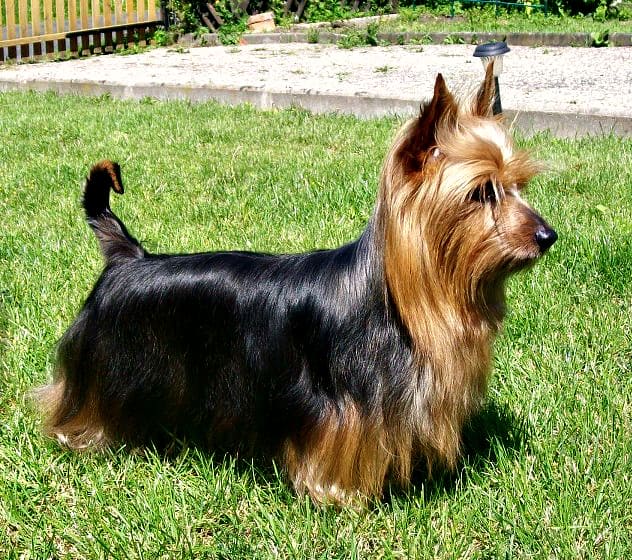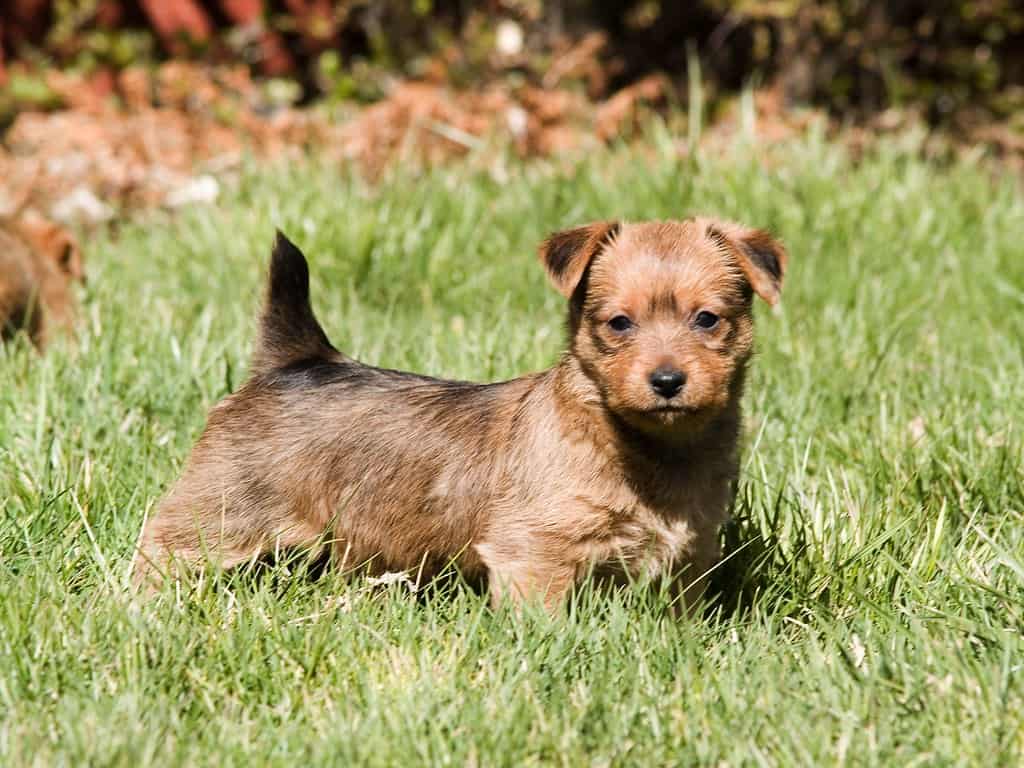Australian Terriers have a history that traces back to the land down under. Explore their heritage, understand the care they require, and appreciate the plucky and resilient traits that make them extraordinary companions.

| Category (Explanation) | Breed Information |
|---|---|
| Year of Breed Conception | 19th century |
| Country of Origin | Australia |
| Weight (lbs & kg) (Male) | 14-16 lbs (6.5-7.5 kg) |
| Weight (lbs & kg) (Female) | 12-14 lbs (5.5-6.5 kg) |
| Coat Type | Harsh, straight, double coat |
| Color Variations | Blue and tan |
| Shedding Level (Low, Moderate, High) | Low to Moderate |
| Height (cm & in) | 10-11 inches (25-28 cm) |
| Breed Size | Small |
| Trainability (Low, Moderate, High) | Moderate |
| Mental Needs (Low, Moderate, High) | Moderate |
| Intelligence Level (Low, Moderate, High) | Moderate |
| Energy Level (Low, Moderate, High) | Moderate |
| Agility (Low, Moderate, High) | Moderate |
| Loyalty (Low, Moderate, High) | High |
| Playfulness (Low, Moderate, High) | Moderate |
| Exercise Needs | Regular exercise and playtime |
| Guarding Proficiency (Low, Moderate, High) | Low |
| Sociability with Children (Low, Moderate, High) | Moderate |
| Barking Level (Low, Moderate, High) | Moderate |
| Digging Tendency (Low, Moderate, High) | Moderate |
| Destructive Behavior (Low, Moderate, High) | Low |
| Drooling Level (Low, Moderate, High) | Low |
| Obedience Level (Low, Moderate, High) | Moderate |
| Apartment Friendly (Yes/No) | Well-suited for apartment living |
| Inherent Prey Drive | Moderate |
| Physical Risk to Others (Low, Moderate, High) | Low |
| Travel Fatality Risk (Low, Moderate, High) | Low |
| Allergen Potential | Low |
| Health Concerns (List of Common Health Concerns) | Patellar Luxation, Allergies |
| Average Life Expectancy (Life Expectancy in Years) | 12-15 years |
Woof Mastery is reader supported and our articles may contain affiliate links.
Instead of running third party ads that we have no control of we only use links from high-quality companies we are directly partnered with. Making use of these links come at no cost to you our reader, and in many cases have the extra benefit of discounted rates or sign up bonuses.
If you’re interested you can read more about our affiliate policy here.
We appreciate your support and always insure that the products and services we recommend are high-quality, helpful and relevant to the subject at hand!
Australian Terriers have a history that traces back to the land down under. Originating in Australia, they were bred to be versatile working dogs on farms. Their plucky and resilient nature made them invaluable for tasks such as rat hunting and guarding. Over time, Australian Terriers transitioned from working dogs to beloved family pets. Their energetic and lively personality, combined with their distinctive appearance, has made them cherished companions for those who appreciate their spirited and tenacious character.

Australian Terriers have a history that traces back to the land down under. What makes them special is their plucky and resilient nature. Explore their heritage, understand the care they require, and appreciate the plucky and resilient traits that make them extraordinary companions. Australian Terriers are special for their vivacious spirit and unwavering loyalty to their owners.
Australian Terriers have a traditional role that traces back to their origins in Australia. These plucky and resilient dogs were bred for hunting small game and vermin in the harsh Australian outback. Their primary responsibility was to control pests, such as snakes, rats, and other small animals, to protect livestock and homesteads. Their tenacity and courage in the face of challenging conditions made them invaluable as working dogs. Today, Australian Terriers continue to bring their spirited and resilient traits to households as cherished family members, reflecting their historical role as tough and determined working dogs.
Australian Terriers are known for their plucky and resilient personalities. They have a history that traces back to the land down under. These terriers can be affectionate and make great family pets. They are full of energy and require training and socialization to ensure they are well-behaved and resilient companions.
Australian Terriers have a history that traces back to the land down under. They are known for their plucky and resilient personalities. They are typically affectionate with their families and enjoy an active lifestyle. However, their terrier stubbornness may require early and consistent training. They are known for their agility and love for digging. Socialization can help them get along well with other pets and people.
Australian Terriers are small, lively dogs with a rough, dense, and straight coat that comes in shades of blue and tan. They have a well-proportioned body with a distinctive topknot of hair on their head. Australian Terriers have a small, sturdy head with dark eyes and small, erect ears. They have a straight tail and strong, straight legs. They have a plucky and resilient gait, reflecting their history and nature as land down under terriers.
Australian Terriers typically have a rough and weather-resistant coat that can come in various colors. Common coat colors include blue and tan, sandy, or solid red. They may have a darker saddle marking on their back. These variations in coat colors highlight their spirited and rustic appearance.
Australian Terriers have a rough and shaggy double coat that can be blue and tan or solid red. Their distinctive coat and ruff around the neck add to their charming and bold appearance.
Australian Terriers have a low to moderate shedding level. They have a rough, wiry outer coat and a soft undercoat. Regular grooming, including brushing, can help manage shedding and keep their coat in good condition. While they shed minimally, attention to their coat’s texture and occasional grooming sessions can contribute to a healthier coat and reduced shedding. Overall, Australian Terriers are considered to be a breed with moderate maintenance in terms of shedding.
Australian Terriers have a double coat that requires regular grooming. Grooming habits for Australian Terriers include:
Australian Terriers have a moderate to high activity level. As a terrier breed, they are lively, curious, and enjoy physical activities. Daily walks, play sessions, and interactive games are important to keep them mentally and physically stimulated. Australian Terriers may also engage well in canine sports and agility. While they are not excessively hyperactive, they benefit from regular exercise to prevent boredom and maintain good health. Tailor their activities to their age and individual preferences, ensuring a balance between physical and mental stimulation.
Australian Terriers are intelligent and alert dogs. They are quick learners and respond well to training, particularly when positive reinforcement methods are used. Their intelligence is coupled with a confident and independent nature, making them adaptable to various tasks. Australian Terriers thrive on mental stimulation and enjoy engaging in activities with their owners. Their intelligence and agility make them well-suited for activities such as agility trials and obedience training.
Australian Terriers have mental needs that include stimulating activities to keep their intelligent minds engaged. Puzzle toys, obedience training, and interactive play are beneficial for their mental well-being.
Social Interaction: Australian Terriers are social dogs that thrive on regular interaction with their human family members. Providing companionship and attention helps prevent feelings of loneliness and anxiety.
Exercise: Regular physical exercise is essential for Australian Terriers to maintain mental health. Engage them in play and activities that provide both physical and mental stimulation.
Training and Obedience: Obedience training is beneficial for Australian Terriers, providing mental stimulation and reinforcing the bond with owners. Positive-reinforcement training methods work well with this breed.
Routine and Structure: Establish a consistent daily routine to provide Australian Terriers with a sense of security and reduce anxiety. Dogs generally thrive on routine and structure.
Affection and Attention: Show affection and spend quality time with Australian Terriers to fulfill their need for attention and companionship. They form strong bonds with their owners.
Socialization: Early socialization is crucial to ensure Australian Terriers become well-adjusted dogs. Exposure to various people, animals, and environments helps build confidence.
Safe Environment: Create a safe and comfortable environment at home where Australian Terriers can relax and feel secure. Provide a designated space for them to retreat to if needed.
Consistency: Consistency in training and daily routines helps Australian Terriers feel more secure and confident in their environment.
Enter The Woof Mastery

Before bringing an Australian Terrier into your home, it’s important to understand their characteristics and needs. These dogs are known for their intelligence, energy, and loyalty. Regular mental and physical stimulation is essential to keep them happy and well-behaved. Training and socialization should start early to ensure they grow into well-mannered companions. Potential owners should be prepared for grooming needs and committed to providing a loving, active environment for these spirited and affectionate dogs.
Australian Terriers are generally low-risk to others due to their friendly and adaptable nature. Proper socialization and training contribute to positive interactions. Individual temperament, responsible ownership, and early exposure to various environments play key roles in ensuring a well-behaved Australian Terrier.
Australian Terriers can be good family pets, including with children. They are generally affectionate and playful. Early socialization and positive reinforcement training contribute to positive interactions. As with any dog, teaching children how to approach and interact with the dog is important.
Australian Terriers may not be natural swimmers, and their swimming ability can vary. Due to their smaller size and short legs, they may not be as comfortable in the water. If you plan to introduce them to swimming, do so gradually and in a controlled environment. Always prioritize safety, and use a canine life vest if needed.
Remember that Australian Terrier puppies, like all puppies, are eager to please and learn. Positive and consistent training practices will help them become well-behaved, obedient, and happy adult dogs. Building a strong and trusting bond with your puppy through training is a rewarding experience for both you and your canine companion.
Australian Terriers are known for being alert and protective, which may lead to occasional barking. Early training and socialization can help manage their barking tendencies and teach them when it’s appropriate to vocalize. Providing mental stimulation and regular exercise can also contribute to a well-behaved Australian Terrier.
Australian Terriers are adaptable and can live in various environments. They do well in homes with yards for play, but they can adapt to apartment living if they receive sufficient exercise. Regular walks and playtime contribute to their well-being. Australian Terriers thrive when they are part of the family and receive attention and affection. Early socialization helps them become well-mannered companions.
Australian Terriers, being a small breed, are generally more adaptable to travel. Ensure they are safely restrained using a suitable crate or seatbelt harness. Monitor for signs of stress or discomfort and make adjustments as needed. Provide familiar items for comfort, and plan for breaks during long journeys. Positive reinforcement can help create a positive travel experience for Australian Terriers.
Australian Terriers may be prone to specific health concerns. While not all individuals will experience these issues, it’s essential for Australian Terrier owners to be aware of potential health problems and work with veterinarians to maintain their pets’ well-being. Common health concerns in Australian Terriers include:
Regular veterinary check-ups, a balanced diet, proper exercise, and responsible breeding practices can help mitigate some of these health concerns. It’s crucial for Australian Terrier owners to work closely with their veterinarians to monitor their pets’ health and address any issues promptly.
Proper nutrition is crucial for the health and well-being of Australian Terriers. Here are some nutritional habits and best practices to consider for this breed:
Breed-Specific Laws (BSL): Australian Terriers may be subject to breed-specific laws (BSL) in certain areas. These laws are often enacted at the local or municipal level and can vary widely from one jurisdiction to another.
Types of Restrictions: The specific restrictions imposed on Australian Terriers under BSL can include mandatory spaying/neutering, special licensing, liability insurance requirements, muzzling in public, and, in some cases, bans on ownership. The severity of these restrictions depends on local regulations.
Rationale for BSL: BSL is typically implemented based on concerns about public safety and perceived risks associated with specific breeds, often due to incidents involving dog attacks. While Australian Terriers are not inherently aggressive, they can be affected by BSL due to their physical resemblance to breeds that are sometimes included in these laws.
Controversy: It’s important to note that BSL is a controversial topic. Critics argue that it unfairly targets breeds rather than addressing individual dog behavior and that responsible ownership and training should be emphasized instead of breed-specific restrictions.
Local Regulations: To determine if there are breed-specific laws or restrictions regarding Australian Terriers in your area, you should check with your local animal control or government authorities. Be aware of and comply with any local regulations to ensure that you are in compliance with the law while owning an Australian Terrier.
Woof Mastery is reader supported and our articles may contain affiliate links.
Instead of running third party ads that we have no control of we only use links from high-quality companies we are directly partnered with. Making use of these links come at no cost to you our reader, and in many cases have the extra benefit of discounted rates or sign up bonuses.
If you’re interested you can read more about our affiliate policy here.
We appreciate your support and always insure that the products and services we recommend are high-quality, helpful and relevant to the subject at hand!
Myth 1: Australian Terriers are too small and fragile.
Myth 2: They are not good with children.
Myth 3: They are high-strung and hyperactive.
Myth 4: Their grooming needs are excessive.
Myth 5: They are yappy and noisy.
Famous Australian Terrier examples are not as widely documented, but these dogs are known for their cheerful disposition and make wonderful companions for various individuals and families.
The Australian Terrier holds cultural significance in various contexts:
The Australian Terrier, a small and sturdy breed, does not have a widely recognized historical owner. However, these terriers have gained popularity for their friendly and adventurous nature, making them cherished companions in various households.
Australian Terriers, like many breeds, have encountered challenges over the years. Some notable challenges include:
The Australian Terrier is a small, sturdy terrier breed that originated in Australia. It is believed to have been developed from a combination of terrier breeds, including:
Australian Terriers bring a perfect blend of intelligence and adaptability to families. Known for their loyalty and courageous spirit, they make excellent companions. Their manageable size and moderate grooming needs make them suitable for various living conditions. With proper training and socialization, Australian Terriers become affectionate members of the family, adding joy and playfulness to the household.